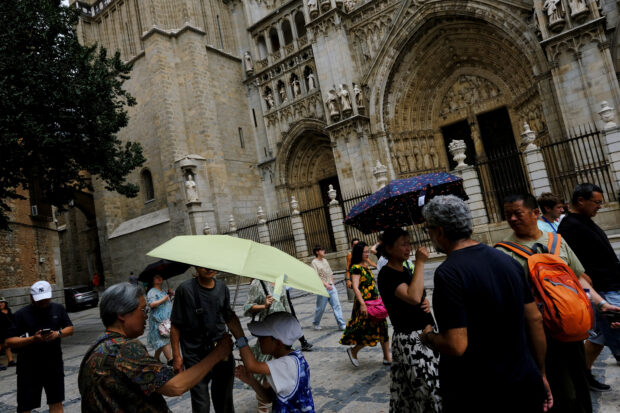
Chinese tourist Xu Kezhi, 7, holds on to an umbrella to protect himself from the sun as he visits Toledo with family during the third heatwave of the summer, in Toledo, Spain, August 9, 2023. REUTERS
MADRID/TOLEDO — Spain’s third heatwave of the summer was set to reach its peak on Wednesday, with temperatures hitting up to 44 degrees Celsius (111 degrees Fahrenheit) in central and southern areas as authorities warned of the risk of wildfires.
The mercury could also rise to 40 C in the Basque Country in northeastern Spain, which is less accustomed to such high temperatures, state weather agency AEMET said.
It warned of dry storms – meaning thunder and lightning without rainfall – in many parts of the country.
Southern European countries have been grappling with record-breaking temperatures this summer, prompting authorities to warn of health risks, particularly for the elderly and those with medical conditions.
Temperatures in some areas in the southern half of Spain remained above 27 C over Tuesday night and Wednesday morning, AEMET spokesperson Ruben del Campo said.
“Wednesday will be the most intense day in terms of extension and temperatures,” Del Campo said, adding that the heatwave will continue until the weekend.
In the central city of Toledo, where the temperature was set to hit 41C, tourists took refuge from the heat in bars equipped with misting fans.
“We need to make the most of the tourist (season),” said Martin, a waiter at El Greco cafeteria. “With these fans at least we can make the terrace a bit more pleasant and fresh.”
At Casa Antonio, which sells traditional Spanish products, owner Alberto Solano was handing out frozen sangria to passing tourists.
“We found some shade and we found some sangria,” said Ryan Williams, 53, a basketball coach from Colorado visiting with his daughter Emily. “It’s very refreshing.”
The heatwaves recorded in Spain and wider Europe this summer have also worsened a prolonged drought, lowering reservoir levels as water evaporation and consumption increase and prompting authorities in Catalonia to impose restrictions.
As Spain suffocates under high temperatures, ice on its mountains is melting.
The Cryosphere, a scientific journal focused on frozen water and ground, published a peer-reviewed paper on Tuesday showing how the Aneto Glacier, the largest in the Pyrenees, is melting and could disappear altogether.
The paper shows the glacier lost about two-thirds of its surface area between 1981 and 2022 and has been reduced to just half a square km. The glacier’s mean ice thickness was reduced by about 30 meters in the same period.
The melting accelerated in 2021 and 2022, both particularly warm years in Spain.